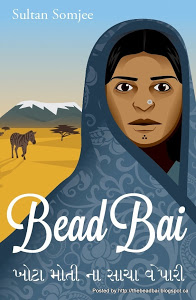BOOK REVIEW
 Bead Bai (ખોટા મોતી ના સાચા વેપારી) by Sultan Somjee
Bead Bai (ખોટા મોતી ના સાચા વેપારી) by Sultan Somjee
CreateSpace, Charleston, SC 29418, U.S.A. – Second Edition 2014
www.thebeaddbai.blogspot.com
Sultan Somjee`s Bead Bai is a real feast of magical realism at its best – a kind of kaleidoscopic poetry in motion! It breaks new ground in `our` literature – a different genre that extends the boundaries of a conventional novel. It is hugely endowed with imagination and daring, yet well grounded in historical research.
 Basically, it is about the settlement of the Satpanth Ismaili Khoja community in East Africa with roots in the princely state of Kathiawar in British India, but Somjee has skilfully contextualised the tales of their arrival and venture into the hinterland with the art and craft of native bead making. He is an ethnographer by academic training and in this extraordinarily ambitious work he has used his learning and professional expertise, gained over many years` field work in Kenya, to perfection.
Basically, it is about the settlement of the Satpanth Ismaili Khoja community in East Africa with roots in the princely state of Kathiawar in British India, but Somjee has skilfully contextualised the tales of their arrival and venture into the hinterland with the art and craft of native bead making. He is an ethnographer by academic training and in this extraordinarily ambitious work he has used his learning and professional expertise, gained over many years` field work in Kenya, to perfection.
If M G Vassanji`s The Gunny Sack was about the inner world of the fictional Shamsi community – the alter ego of the Ismaili Khojas – Bead Bai reaches far and deep into every aspect of the proverbial Asian dukawallahs` lives and businesses. From the opening Introduction, these passages neatly give the flavour of what is to follow :
`From mid-19th century onwards, there was a steady migration of Satpanth Ismailis from India to East Africa increasing to greater numbers in the late 19th to early 20th centuries. Already by the early 20th century, some Satpanth Ismaili merchants had developed trade networks running from the East Coast of Africa towards the Congo. Their foot caravans included beads among other goods, such as blankets, cloth, foodstuff, and building material. The bead trade developed by trial and error as the merchants tested preferences in colours, lustre, sizes and shapes, among the ethnic people.`
(and)
`Thus, over time the bead merchants of East Africa learned how different and particular were the over hundred ethnic groups when it came to their art.`
Although the chapters are serially numbered, they are nevertheless grouped together into several Parts, each with an epigrammatic intro, such as `Stories from Shantytown` in Part One. Here he cites, in addition to other references, an undated (and unpublished) paper by a veteran Kenyan Oshwal businessman Amritlal Raishi outlining the building up of what is now known as Nairobi`s Biashara Street by (A M) Jeevanjee from its ramshackle beginning at the turn of the 20th century.
An extraordinary feature of the story (to call it a `novel` does not do justice to its broader appeal as a work of fiction enriched by factual history) is that the author has entrusted its telling to a female character (from his man`s pen, that is), Sakina, born in Nairobi on 15th March 1922, `on the day when the colonial soldiers opened fire on the crowd protesting against the imprisonment of Harry Thuku`, who had `defied the governor`s order on the wearing of the hated kipande` – a subtle reminder that all this was happening during the heyday of Empire!
The narrative continues and is threaded through such early chapters as `Stories arriving with the monsoons`, `Stories departing with the monsoons`, `Story of Sohn Bai`, `Losing the land`, `Crows on Board the Dhow`, `There were three prostitutes at sea` and `Deaths on Kala Pani`.
The spread of the community across the Indian Ocean and beyond is further explored under various headings, including `Chup Chap Whispers`, `The Stone Jamat Khana`, `At the Religious School` and `Stories from Meethi Bai`s Lodge`. In the process, we are treated to an indepth insight into the very soul and character of the Khojas.
The Gujarati sub-title of the book comes from the signage on the shop premises of Nagji Pademsi and Sons (`popularly called Duka la Ushanga na Blanketi, the Bead and Blanket Store`) that, according to the author (at page 127) transliterated as `Of Imitation Pearls We Are Genuine Merchants`, though a nuanced version of it might have been `True Merchants of Imitation Beads`! In the next chapter (`Loving Gujarati`) Somjee extols the beauty and complexity of the language in, it has to be said, loving homage.
In other chapters, he delves into the history of the Raj and the relationship between the British rulers and Indian princes, with a passing mention of the famous Aga Khan Case in the High Court of Bombay that definitively declared who the Ismaili Khojas were and how he, the Aga Khan (“Saheb”) came to be their leader. There is also a mischievous local folklore reference to Gandhi`s alleged sexual peccadillo in Zanzibar en route to South Africa as recounted by Ma, the narrator`s mother-in-law.
The reader cannot but be impressed by Somjee`s brilliant eye for detail. A graphic example of this is in his description of the minutiae of domestic drudgery that was traditionally the lot of the newly married daughter-in-law, in this case Sakina, who, besides having to perform the routine tasks of cleaning and cooking (“Bride as Housemaid”), was expected to meet her husband`s conjugal demands and to generally keep the household running smoothly under the stern and watchful eye of Ma, appropriately dubbed `Mama Khelele` by the Maasai milk women who came to the back door of the house daily with their fresh produce and engaged in banter with everyone present.
Although the focus of the book is the trajectory of the Khojas, the fact that they came from the same cultural, ethnic and regional background as the other Gujarati community groups (Hindu and Moslem) who were also part of the Indo-African migrationary trail means that it is richly steeped in resonances of commonalities and shared experiences.
When, therefore, I read `Haiderali was born in Zanzibar. His father, Khimji Devji Momna, …. lived on Mla Ndege Street in the stone town …` (p 286), as reviewer I was not surprised, though as an `insider` I felt a bit chuffed that Somjee should have chosen the name “Khimji Devji”, which also happened to be my father`s! The name recurs again more than once, later to become “Khimji Devji Momna and Son, Beads and General Store”, which, incidentally, illustrated how the pioneer migrants were able to prosper and continue their line down successive generations. In a similar vein, my father`s business, albeit of a different kind, was also after three decades transformed into “Shah Khimji Devji & Sons” exactly sixty years ago, though I myself was not one of the sons!
At this point, Somjee encapsulates the symbiotic relationship between Khoja and Maasai, between the Indian newcomer and the native inhabitant of the land, under `Storyteller of the Savannah` (Chapter 39) evocatively described by the narrator thus:
` … the new person that I am becoming … shaped by how I am viewed – a wife, a daughter-in-law, expectant carrier of family name and honour, a cook and servant in the house, but an adorned lady of Devji family in the jamat khana. What tells me who I am …. is the two hours on the veranda of the shop with Ole Lekakeny … [and] the old man`s nieces … the long milk gourds … [t]he milk was their food while they were in town for a day or two, and for their journey to and from their homesteads. They walked three days … stopping at homesteads of their cousins, age group friends and aunts, refilling their milk gourds. One afternoon Ole Lekakeny teaches me how to compose a Maasai bead pattern. His name, Ole Lekakeny, means dawn, for he was born when the colours of the sky were pure.`
And it goes on:
` … There is freedom in my heart … listening to lyrics of Ole Lekakeny explaining the emankeeki and the origin of colours and man. He reminds me so much of Dadabapa singing the Das Avatar and how God came to be fish and an animal before becoming a man. Dadabapa also told me how we came to Africa, cramped in a wooden craft ….`
How 'we came to Africa' above was an echo of Cynthia Salvadori's `We Came in Dhows` ! There is so much packed into the book`s 457 pages, including a useful glossary and heart-felt acknowledgements, but not counting the Introduction (and lacking, alas, an index or a list of contents), that it is an invidious task to summarise it all fairly. Suffice it to say that Bead Bai will serve as a most valuable contribution to the documented history not only of the Ismaili Khoja presence in East Africa but also, vicariously, of their other Gujarati counterparts. It cannot be recommended too highly.
© 2014
e.mail : rkds47@hotmail.com
![]()

